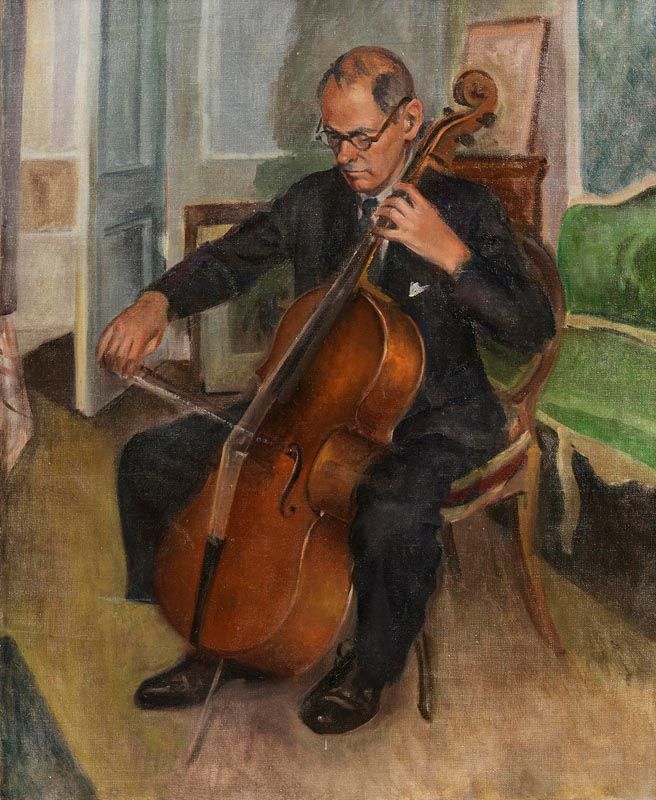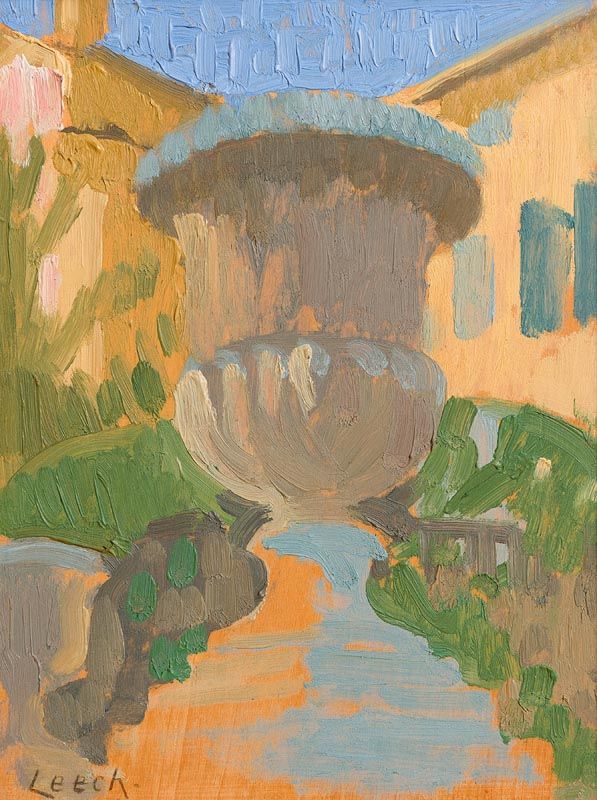Artist: William John Leech RHA ROI (1881-1968) Title: Tug on the River Thames Signature: signed lower left Medium: oil on board Size: 13 x 20cm (5.1 x 7.9in) Framed Size: 33.5 x 40.5cm (13.2 x 15.9in) Provenance: James Adams, Dublin, Important Irish Art, 1st June 2016, Lot 37; Private Collection a#morebtn { color: #de1d01; } a#morebtn:hover { cursor: pointer;} A view of the river Thames, this small but exquisite oil painting by William Leech depicts tugs moored below Southwark Bridge, with the dome of St. Pauls Cathedral visible in the distance. Tug on the River Thames may perhaps date from 1937-38, from ... Read more A view of the river Thames, this small but exquisite oil painting by William Leech depicts tugs moored below Southwark Bridge, with the dome of St. Pauls Cathedral visible in the distance. Tug on the River Thames may perhaps date from 1937-38, from just before the Second World War, when Leech and his friend Sydney Thompsona New Zealand artist he had known since their days together in Brittanybegan to paint views of the Thames at Billingsgate. However an alternative, and more likely, date for this painting is the winter of 1945, when Leech, who had a studio at Steeles Road, off Haverstock Hill, returned to Billingsgate to paint views of the river, including bombed-out areas around St. Pauls. If the later date is correct, Tug on the River Thames is an evocative homage to a city which had just emerged from years of destruction. Many of the buildings around St. Pauls had been destroyed in the Blitz, but the cathedral, rising above the ruins, remained a symbol of the resilience of London, and of Londoners. Leech took his view looking west along the river, but his image is idealised, and the bridges depicted are not in their correct order. In 1945, the three bridges east of St. Pauls were Southwark, Cannon Street and London Bridge. The artist evidently positioned himself close to the massive girders of Cannon Street Bridge, but rather than depicting its box-like structure, he instead used the graceful arch of London Bridge, the next downstream crossing, to frame Southwark Bridge. Built of stone, London Bridge had not yet been replaced by the concrete structure that exists today. Leech simply ignored Cannon Street Bridge, creating instead a composition in which the horizontal curves of arches are counterpointed against vertical silhouettes of trees on the riverbank. These trees again represent a degree of artistic licence, with Leech evoking a sylvan image of the Thames. While the image may be idealised or romanticised, the real subject of this painting is the texture and colour of oil paint itself, with Leechs flickering, confident brush marks creating a wonderful image on a small wooden panel. The artist revelled in grey and green tonalities, while introducing occasional flashes of colour, as in the plumes of blue smoke rising from tugs moored between the bridges. On the reverse of the painting is a fragment of a framers label, dating from around the 1940s, with the address 131 Waverly . . New York. In the winter of 1945, London would have been full of American civilian and military personnel, preparing to embark on a return journey to the United States. It is tempting to imagine this painting being bought by an American collector, brought back to New York, and framed at Waverley Place in Greenwich Village; or possibly the painting was exhibited in New York, and purchased there. Peter Murray, March 2019
Artist: William John Leech RHA ROI (1881-1968) Title: Tug on the River Thames Signature: signed lower left Medium: oil on board Size: 13 x 20cm (5.1 x 7.9in) Framed Size: 33.5 x 40.5cm (13.2 x 15.9in) Provenance: James Adams, Dublin, Important Irish Art, 1st June 2016, Lot 37; Private Collection a#morebtn { color: #de1d01; } a#morebtn:hover { cursor: pointer;} A view of the river Thames, this small but exquisite oil painting by William Leech depicts tugs moored below Southwark Bridge, with the dome of St. Pauls Cathedral visible in the distance. Tug on the River Thames may perhaps date from 1937-38, from ... Read more A view of the river Thames, this small but exquisite oil painting by William Leech depicts tugs moored below Southwark Bridge, with the dome of St. Pauls Cathedral visible in the distance. Tug on the River Thames may perhaps date from 1937-38, from just before the Second World War, when Leech and his friend Sydney Thompsona New Zealand artist he had known since their days together in Brittanybegan to paint views of the Thames at Billingsgate. However an alternative, and more likely, date for this painting is the winter of 1945, when Leech, who had a studio at Steeles Road, off Haverstock Hill, returned to Billingsgate to paint views of the river, including bombed-out areas around St. Pauls. If the later date is correct, Tug on the River Thames is an evocative homage to a city which had just emerged from years of destruction. Many of the buildings around St. Pauls had been destroyed in the Blitz, but the cathedral, rising above the ruins, remained a symbol of the resilience of London, and of Londoners. Leech took his view looking west along the river, but his image is idealised, and the bridges depicted are not in their correct order. In 1945, the three bridges east of St. Pauls were Southwark, Cannon Street and London Bridge. The artist evidently positioned himself close to the massive girders of Cannon Street Bridge, but rather than depicting its box-like structure, he instead used the graceful arch of London Bridge, the next downstream crossing, to frame Southwark Bridge. Built of stone, London Bridge had not yet been replaced by the concrete structure that exists today. Leech simply ignored Cannon Street Bridge, creating instead a composition in which the horizontal curves of arches are counterpointed against vertical silhouettes of trees on the riverbank. These trees again represent a degree of artistic licence, with Leech evoking a sylvan image of the Thames. While the image may be idealised or romanticised, the real subject of this painting is the texture and colour of oil paint itself, with Leechs flickering, confident brush marks creating a wonderful image on a small wooden panel. The artist revelled in grey and green tonalities, while introducing occasional flashes of colour, as in the plumes of blue smoke rising from tugs moored between the bridges. On the reverse of the painting is a fragment of a framers label, dating from around the 1940s, with the address 131 Waverly . . New York. In the winter of 1945, London would have been full of American civilian and military personnel, preparing to embark on a return journey to the United States. It is tempting to imagine this painting being bought by an American collector, brought back to New York, and framed at Waverley Place in Greenwich Village; or possibly the painting was exhibited in New York, and purchased there. Peter Murray, March 2019















Try LotSearch and its premium features for 7 days - without any costs!
Be notified automatically about new items in upcoming auctions.
Create an alert